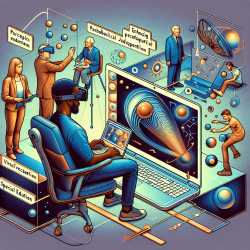Introduction
In the realm of online therapy, especially within educational settings, understanding the nuances of perception can significantly enhance therapeutic outcomes. The study titled "Perceptual judgments of duration of parabolic motions" offers intriguing insights into how we perceive motion, which can be instrumental for practitioners in the field of special education and therapy.
Understanding the Research
The research explores how observers perceive the duration of ball motions in a virtual reality setting, focusing on parabolic trajectories. These motions were analyzed under three different laws of motion: constant tangential velocity, constant vertical velocity, and gravitational acceleration. The study found that while all types of motion were perceived accurately, those with constant tangential velocity were judged with slightly more precision.
This finding suggests that our brains might use a heuristic model to interpret gravitational effects, relying on internal representations rather than precise kinematic calculations. Such insights could be invaluable for therapists aiming to develop strategies that align with natural perceptual tendencies.
Implications for Practitioners
For practitioners, these findings highlight the importance of leveraging natural perceptual processes in therapy. Here are some practical applications:
- Virtual Reality in Therapy: Incorporating VR scenarios that mimic natural motion patterns can enhance engagement and effectiveness in therapy sessions.
- Focus on Natural Motion: Designing activities that involve natural motion trajectories can aid in better perceptual judgments and improve motor learning.
- Heuristic Learning: Encourage heuristic learning by providing experiences that align with intuitive physics, helping clients internalize motion concepts more effectively.
Encouraging Further Research
While the study provides a foundation, there is ample room for further exploration. Practitioners are encouraged to delve deeper into how these perceptual judgments can be harnessed in therapeutic settings. Questions such as how these findings translate to different populations or how they can be integrated into specific therapeutic interventions remain open for investigation.
Conclusion
Understanding perceptual judgments of motion duration can revolutionize how therapy is conducted, especially in virtual environments. By aligning therapeutic practices with natural perceptual tendencies, practitioners can create more effective and engaging interventions. As we continue to explore the intersection of perception and therapy, the potential for innovation is boundless.
To read the original research paper, please follow this link: Perceptual judgments of duration of parabolic motions.










